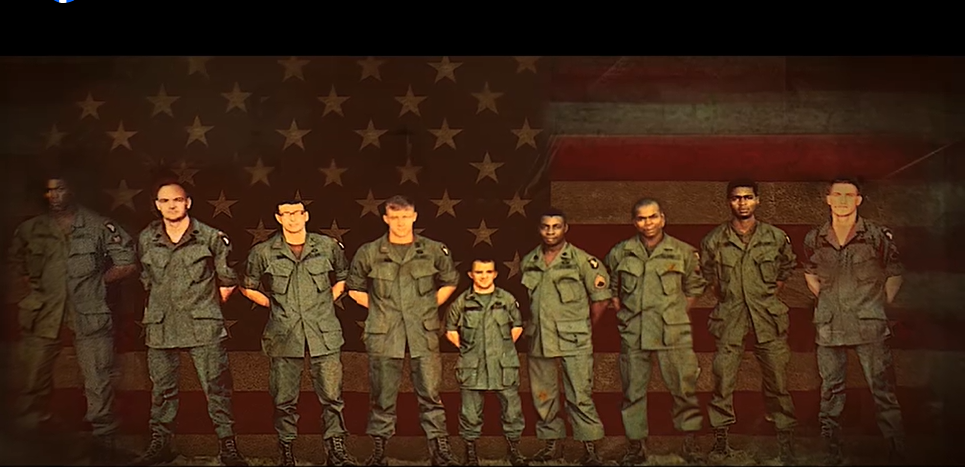
On a good day I am five feet four inches short tall.
As a “shortie” I love to read stories about short people who “make it big.”
No wonder Napoleon Bonaparte is one of my heroes. Le petit caporal is said to have been five-feet-two at the time of his death.*
As a “shortie,” I was rather proud of having overcome such an “obstacle” early in my military career.
Then I read about Green Beret Captain Richard J. Flaherty and how much more serious his obstacles were and how much bigger his accomplishments became.
Born November 28, 1945, in Stanford Connecticut of Irish ancestry, Flaherty grew to only 4 feet, 9 inches.
Coming from a military family, Flaherty wanted nothing more than to serve his country.
Aware of his small stature, Flaherty immersed himself in martial arts, athletics and in other ways to achieve the best possible physical condition.
He volunteered for the Army, but was turned down because of his size.
Undaunted, Flaherty continued his determined effort to join the Army.
Finally, supported by his local Congressman, he received a waiver and was admitted to the U.S. Army in 1967. It is said he was the smallest (in height) serviceman in the U.S. military at the time.
In Army basic training, Flaherty was bullied and harassed by both fellow soldiers and drill sergeants. Such prejudice would continue in Infantry Officer Candidate School (OCS) at Fort Benning, Ga. However, Flaherty persevered and graduated from OCS on August 31, 1967, as a 2nd Lieutenant.
He became an elite paratrooper and, later, a Green Beret. He deployed with the Screaming Eagles to Vietnam at the height of the Vietnam War. Assigned to the 101st Airborne Division, where he served as a Platoon Leader and as a Recon Platoon Leader, Flaherty bravely led his men in some of the fiercest fighting on the outskirts of Hue during the Tet Offensive.
He was wounded twice, “but as soon as he was patched up he jumped right back into the battle.”
As the Recon platoon leader with Echo Company, Flaherty led his unit in dangerous search and destroy missions deep into North Vietnamese Army and Viet Cong territory.
Flaherty returned to the U.S. in 1969 to attend the Special Forces School Officer Course at Fort Bragg, N.C., an assignment for which he had to gain six pounds and get another height waiver.
Upon graduation, he returned to South East Asia, this time as an elite Green Beret with the 46th Special Forces Company in Thailand, where he, as a newly minted Captain, led clandestine missions into the so-called “Pink Zones” on “the other side of the fence” fighting Malaysian and Burmese guerrillas.
For his gallantry in action, heroic service, combat wounds and other meritorious achievements, Captain Flaherty was awarded – among other –The Silver Star, two Bronze Stars, two Purple Hearts, the Air Medal, and the (Republic of Vietnam) Gallantry Cross W/Silver Star.
In 1970 Capt. Flaherty was reassigned to the 10th Special Forces Group at Fort Devens, MA. Where he served as a Detachment Commander.
In 1971, as the military branches underwent severe “Reductions in Force” (RIF), Flaherty was discharged, apparently a devastating blow to him, aggravated by some personal tragedies.
He descended into the obscure world of military and private contract work. Work that would take him to assignments in Rhodesia, Angola, other African countries and exotic destinations with the CIA, NSA and, later, in the U.S. with the Bureau of Alcohol, Tobacco, Firearms and Explosives.
David Yuzuk documents Flaherty’s clandestine missions in his bestselling book, The Giant Killer. A story he wrote after a “three-year journey of discovery [that]dragged [him] down the rabbit hole of CIA conspiracies and the hunt for stolen classified weapons—stretching from the bloody jungles of Vietnam to the dangerous streets of Iraq and Venezuela…”
Giant Killer amazon.com
It is also a story that includes homelessness for the Green Beret on the streets of Aventura, Florida, where Yuzuk befriended Flaherty. A friendship that would tragically end fifteen years later when Flaherty was killed in a hit-and-run accident in Miami, Florida. Captain James R. Flaherty was 69.
A review of Yuzuk’s book, The Giant Killer, describes Captain Richard Flaherty, “the shortest man in the Army,” as “a bona fide war hero and beloved leader…of small stature…cut from the Army that was his life after two tours in Vietnam…”
*Napoleon was probably somewhat taller. The height reported by officials at the time of his death (“5 pieds 2 pouces“) may have been in French measurements of the time when the French inch was 2.7 cm. In imperial measurements that would make Napoleon just under 5’6”.
===
CODA:
Now, about my “obstacle.”
When I joined the U.S. Air Force almost seven decades ago, my dream was to fly.
I passed all aptitude tests and physical exams to become an aircrew member.
All except for one: I “topped” at 63 ½ inches while the minimum height requirement for an aircrew member was 64 inches. I was disqualified and devastated.
I persevered, was granted a waiver and was able to “follow my dream.”
I do not know about the other Services, but in May 2020, the Air Force removed blanket heigh requirements for officers who are otherwise qualified to become aviators. Men and women shorter than 5’4″ or taller than 6’5″could apply and, if otherwise qualified, would be able to fly certain aircraft in the Air Force’s fleet.
In the Spring of 2021, the Air Force established new height standards for career enlisted aviators, ranging from 4’10” to 6’8″ depending on specialty.
Addressing the first change, Gwendolyn DeFilippi, assistant deputy chief of staff for manpower, personnel and services, said at the time, “This is a huge win, especially for women and minorities of smaller stature who previously may have assumed they weren’t qualified to join our team.”
















